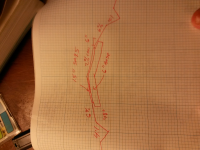Buppies
Super Star Member
- Joined
- Oct 26, 2011
- Messages
- 12,298
- Location
- SouthWestern Virginia
- Tractor
- Kubota L5240 EX mark 60 in 29 hp Toro 60inch Z Master 21 inch walk behind Polaris 900 hunter edition 30in toro walk behind
The thickness of asphalt has nothing to do with how long it will last the base is what's all important(stone).
Several commentors here know what they are talking about. Asphalt should be laid in place depending on type (base mix BM25 or topping SM9.5A) at mix temperature 275 degrees up to 350 degrees. Maximum compaction takes place before 175 degrees. A one ton roller given enough passes will obtain proper compaction (normally 92% on nuclear gauge). A three to five ton roller will achieve compaction faster anything larger will be too large for driveway
If asphalt is laid and rolled to quickly the mat will split leading to premature failure. The seams of the different mats should be looped correctly so as to not leave large stone (segration) which leaves voids leading to premature failure. The trucks should also be loaded in a proper sequence to prevent segration
The depth of stone is determined by geotechnical tests and should be below the freeze line. Stone base is most important asphalt is only a running surface and has no structural integrity by itself
The stone base should be compacted to 95% on the nuclear gauge more than that will lead to failure down the road since once you go over 100% the base begins to degrade
As I am not in your area cannot really comment on costs as they can very greatly from region to region
If your individual use is residential and not big trucks then 2in of compacted asphalt is sufficient. Remember stone base and properly compacted is your friend and is where your money should be spent. If larger trucks dump and up 3in of base mix asphalt then 2in of topping
Hopefully this information is helpful
Several commentors here know what they are talking about. Asphalt should be laid in place depending on type (base mix BM25 or topping SM9.5A) at mix temperature 275 degrees up to 350 degrees. Maximum compaction takes place before 175 degrees. A one ton roller given enough passes will obtain proper compaction (normally 92% on nuclear gauge). A three to five ton roller will achieve compaction faster anything larger will be too large for driveway
If asphalt is laid and rolled to quickly the mat will split leading to premature failure. The seams of the different mats should be looped correctly so as to not leave large stone (segration) which leaves voids leading to premature failure. The trucks should also be loaded in a proper sequence to prevent segration
The depth of stone is determined by geotechnical tests and should be below the freeze line. Stone base is most important asphalt is only a running surface and has no structural integrity by itself
The stone base should be compacted to 95% on the nuclear gauge more than that will lead to failure down the road since once you go over 100% the base begins to degrade
As I am not in your area cannot really comment on costs as they can very greatly from region to region
If your individual use is residential and not big trucks then 2in of compacted asphalt is sufficient. Remember stone base and properly compacted is your friend and is where your money should be spent. If larger trucks dump and up 3in of base mix asphalt then 2in of topping
Hopefully this information is helpful
Last edited:

